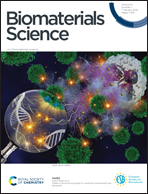A rhabdomyosarcoma hydrogel model to unveil cell-extracellular matrix interactions†
Abstract
Three-dimensional (3D) culture systems have progressively attracted attention given their potential to overcome limitations of classical 2D in vitro systems. Among different supports for 3D cell culture, hydrogels (HGs) offer important advantages such as tunable mechanical and biological properties. Here, a biocompatible hyaluronic acid-polyethylene glycol HG was developed to explore the pro-migratory behavior of alveolar rhabdomyosarcoma (ARMS) cells. Proteomic analysis of ARMS xenografts unveiled the composition of the extracellular matrix (ECM) elucidating the most representative proteins. In parallel, HGs were obtained by the combination of a thiol-containing hyaluronic acid derivative and different polyethylene glycol (PEG) dimaleimide polymers. The selection of the optimal HG for ARMS cell growth was made based on degradation time, swelling, and cell distribution. Rheology measures and mechanical properties were assessed in the presence or absence of ECM proteins (collagen type I and fibronectin), as well as viability tests and cell distribution analysis. The role of ITGA5, the receptor of fibronectin, in determining ARMS cell migration was validated in vitro upon ITGA5 silencing. In vivo, cell dissemination and the capacity for engrafting were validated after injecting ARMS cell populations enriched for the level of ITGA5 in zebrafish embryos. To study the interactions with ARMS-specific ECM proteins (HG + P), the key players from the Rho and heat-shock pathways were investigated by reverse phase protein array (RPPA). Our data suggest that the developed 3D ARMS model is useful for identifying potential physical hallmarks that allow cancer cells to resist therapy, escape from the immune-system and increase dissemination.



 Please wait while we load your content...
Please wait while we load your content...